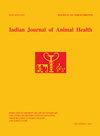印度哈里亚纳邦健康猪和腹泻猪的星状病毒检测和鉴定
IF 0.5
4区 农林科学
Q4 AGRICULTURE, DAIRY & ANIMAL SCIENCE
引用次数: 0
摘要
背景:猪星状病毒(PAstV)是一种从健康猪和腹泻猪的粪便中检测到的新兴病原体,比较PAstV和腹泻猪存在的研究有限。PAstV在世界各地都有报道,印度也有一些报道。此外,关于编码病毒衣壳蛋白的ORF2区氨基酸序列变异的报道有限。本研究旨在研究印度北部哈里亚纳邦不同年龄组猪中PAstV的存在、与腹泻的关系及其分子特征。方法:收集哈里亚纳邦不同地区猪直肠拭子176份。采用ORF1b/ORF2部分基因组区的RT-PCR方法筛选PAstV。对阳性样本进行分子分型和系统发育分析。结果:16.47%的猪粪便标本检出PAstV,其中腹泻性标本21/127(16.53%),非腹泻性标本8/49(16.32%)。结果表明,断奶仔猪对PAstV的易感程度最高,哺乳仔猪次之。系统发育分析显示,在哈里亚纳邦存在PAstV4和PAstV2世系。该研究显示该地区特有的病毒存在,并且在PAstV毒株之间具有高度的遗传多样性,这表明存在广泛的异质性。本文章由计算机程序翻译,如有差异,请以英文原文为准。
Porcine Astrovirus Detection and Characterization in Healthy and Diarrheic Pigs from Haryana, India
Background: Porcine astrovirus (PAstV) is an emerging pathogen detected from the feces of both healthy and diarrheic pigs with limited studies comparing the presence of PAstV and diarrhea in pigs. PAstV has been reported worldwide with a few reports from India. In addition, there are limited reports on variation in the amino acid sequence of the ORF2 region, which codes for viral capsid protein. The present study was aimed to study the presence of PAstV, association with diarrhea in pigs of various age groups and its molecular characterization from Haryana, a northern Indian state. Methods: A total of 176 rectal swabs of pigs were collected from different parts of Haryana. The samples were screened for PAstV by RT-PCR of the partial ORF1b/ORF2 genomic region. The positive samples were characterized by molecular typing and phylogenetic analysis. Result: In the present study, PAstV was detected in pigs in 16.47% of fecal samples, including 21/127 (16.53%) diarrheic and 8/49 (16.32%) non-diarrheic. The results indicated that weaning piglets were more susceptible to PAstV infection followed by suckling piglets. The phylogenetic analysis revealed the circulation of PAstV4 and PAstV2 lineages in Haryana. The study revealed endemic presence of virus in the region with high genetic diversity among the PAstV strains, suggesting a wide range of heterogeneity.
求助全文
通过发布文献求助,成功后即可免费获取论文全文。
去求助
来源期刊

Indian Journal of Animal Research
AGRICULTURE, DAIRY & ANIMAL SCIENCE-
CiteScore
1.00
自引率
20.00%
发文量
332
审稿时长
6 months
期刊介绍:
The IJAR, the flagship print journal of ARCC, it is a monthly journal published without any break since 1966. The overall aim of the journal is to promote the professional development of its readers, researchers and scientists around the world. Indian Journal of Animal Research is peer-reviewed journal and has gained recognition for its high standard in the academic world. It anatomy, nutrition, production, management, veterinary, fisheries, zoology etc. The objective of the journal is to provide a forum to the scientific community to publish their research findings and also to open new vistas for further research. The journal is being covered under international indexing and abstracting services.
 求助内容:
求助内容: 应助结果提醒方式:
应助结果提醒方式:


